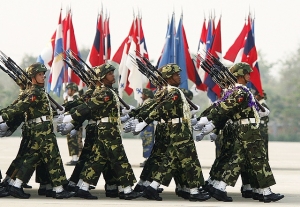By. Banya Hongsar (24 July 2011) – Nationalism is not death in Burma. Burma’s nationalism brought independent to Burma from the colonial rules for over 80 years. Nationalism is legacy of Burma’s new army tatmadaw formed in 1947 in Bangkok. It is nationalism brought freedom from colonial rules and destroyed freedom for its citizen in Burma. Burma is again in active armed conflict that killed civilians, forced civilian to flee home and destroyed farmland, properties and forced displaced persons to cross border to Thailand, China, India and elsewhere. Nationalism and war is legacy of old and new Burma. It is time that Burmese people, as a whole from all sides of political persuasion review, reflect and rebuild a peaceful community under principle of fairness and human rights in new era.

After 100 days of formation of new government, Burma new president U Thein Sein and his cabinet confront two battles; strengthening new government’s power in the urban land and keeping security in rural and borderland that controlled by ethnic armed insurgent organizations. A test for new government is real in both fronts. It is a test of new politics of Burma. Institutional building is far from reach as expected by local and international Burma experts.
Strengthening executive power of the new government is challenged by its own military elites. Military hardliners among the government circles hold strong stand not to compromise any political spaces with leading opposition force led by Daw Aung San Suu Kyi and others. The new government has little room to move unless the military hardliners backed any proposal for negotiation with Daw Suu and her circles.
Keeping security in rural and borderland within ethnic populated areas is under challenged this month. Key ethnic armed organizations resisted any attempt of the government troops when they are treated to disarm and incorporated into ‘border guard force (BGF)’ proposed by the new government under the blinded constitution. Almost all ethnic states are engaged with armed conflicts after the formation of new government in January.
The Kachin State is the case of new development. However, Burma’s nationalism is shaped from attacking to colonize its own local ethnic populations for over half a century. Burma’s scholar and US based writer, Thant Myint U clearly observed in 2006 in his most acclaimed book ‘when the men in uniform looked to the past, they say a country that tended to fall apart into little pieces and that had always needed to be melded together by force. They saw themselves in a long line of national unifier and see their task as unfinished’. However, building a peaceful coexistent among all ethnic people is the ultimate goal of new Burma as laid the principle of unity in 1947 Pang-long Agreement.
Burma’s born Win Min, Thailand based observer and commentator correctly asserted (2010) ‘after ruling the country for almost half a century, Burma / Myanmar’s military is deeply politicized, and the administration and civil services have been militarized as a result. Consequently, there is also a political deadlock while the country suffers from socio-economic mismanagement’. He further added that ‘they (the army) also see themselves as the saviors of the country and its citizens, protecting them from the threat of ethnic nationalist armies and foreign influences’. The ethnic nationalists are born as the result of Burman’s nationalism and militarization toward assimilation.
This history indicated that the Burman’s nationalists expanded their social, cultural, political within non-Burman’s ethnic population by force of military might in the country for half of the century. The Burman’s nationalists are not concerned of foreign influences but also local rivals from other major ethnic like Shan, Karen, Kachin and Mon.
Representations of ethnic stages to national and local assembly have little or no voice that could contain the spreading of armed fighting within their own states and constituencies. Ethnic MPs and legislators could not influence for peace building. The whole ceasefire process within 17 ethnic armed organizations has been ended in 2011 after the election. The new government has not declared either the government is under war or peace to any of the ethnic armed groups, but a preparation for war is underway by the tatmadaw commanders in each state. Thailand, China and India are now hosting over 200, 000 Burma’s displaced persons in theirs respected border areas.
Mary P. Callahan, Burma’s researcher from Cornell University asserted in 2004 that ‘in Burma, no one in the central regions ever questioned the morality or efficiency of the tatmadaw’s counterinsurgency campaigns in the ethnic minority regions. The idea that minority citizens were potential enemies became orthodoxy for ethnic-majority Burmans committed to holding the Union together’. Keeping a united Burma within armed force and military might only result human suffering and poverty as we all have seen in the current situation.
Reassessing road map to democracy will be urgently required by the new government, if it is really building peace in entire Burma for entire security in Burma and peaceful transition in the country. Unconditional peace agreement should be placed as priority by the government. Burman and non-Burman ethnic nationalism are rooted in past and present political thinking has been long enough.
Nationalism played a key part in struggling for Burma’s independent but it will less likely to play a major factor for building a peaceful transition to democracy, human rights and federalism within Burma’s multi-ethnic people. It is time that new government, ethnic leaders and armed organizations within Burma to review, reflect and re-write the new chapter of Burma history with tolerance, acceptance and equality under the rule of laws for all.
